Everyone seems to enjoy the brief and sometimes dazzling streaks of light from meteors, sometimes called "shooting stars." The two best meteor showers in 2015 will be the Perseids in mid-August and the Geminids in mid-December.
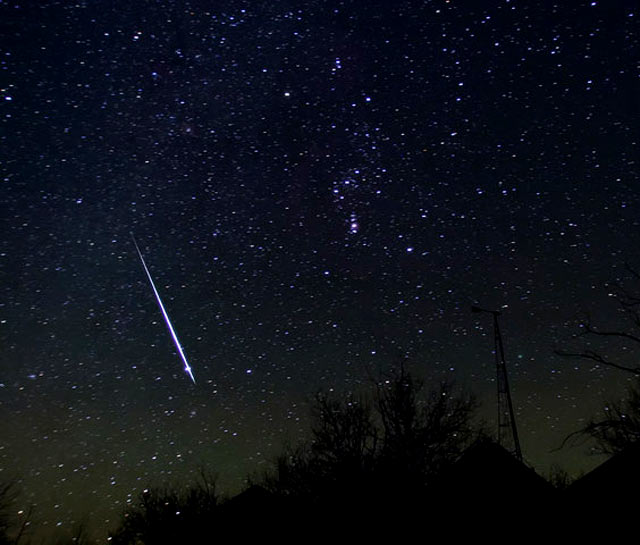
Alan Dyer
If you watch the starry night sky from a dark location, a few times every hour you'll see brief streaks of light from meteors, sometimes called "shooting stars." Derived from the Greek word meteoros (meaning "high in the air"), meteors are bits of interplanetary debris slamming into Earth's upper atmosphere at altitudes of 50 to 75 miles (80 to 120 km).
The particles hitting our atmosphere are not large — typically they're no bigger than big sand grains, and something the size of a pea can create a meteor that's dramatically bright. That's because they strike at 20 to 45 miles per second, and all that kinetic energy is rapidly dissipated by frictional heat. In fact, we see a meteor's streak not because the particle is "burning up," but instead because air molecules along its path become flash-heated to thousands of degrees.
Meteors can occur at any time on any night and appear in any part of the sky. On most nights a half dozen of these sporadic (random) meteors appear hourly.
What is a Meteor Shower?
However, several times each year, Earth encounters a stream of gritty debris left in space by a passing comet, and the result is a meteor shower. You'll notice the difference if you watch the sky for a half hour or so during one of these events: not only do the number of meteors you'll see go up, but also the meteors seem to fly away from a common point in the sky called the radiant. This is a trick of perspective, because all these particles are traveling in parallel — part of a vast but sparse "river of rubble" that's spread all around the comet's orbit.
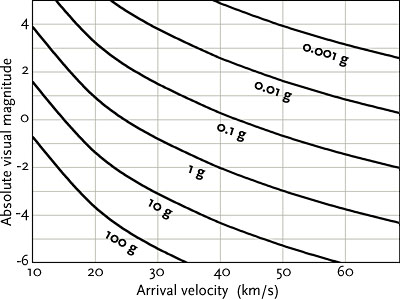
M. Campbell-Brown / P. Brown
A shower gets its name from the constellation where this radiant lies — for example, August's well-known Perseid shower has its radiant in Perseus. One notable exception to this rule is the Quadrantid shower, named for the now-defunct constellation Quadrans Muralis. Its radiant lies in the constellation Boötes. In any case, the higher a shower’s radiant, the more meteors it produces all over the sky.
Meteor showers usually peak during the predawn hours on the dates listed below, though they're typically active a few nights before and after the peak date. Note that the rates are for ideal conditions: very dark skies free of moonlight or light pollution, with the radiant nearly overhead. Most likely you'll see somewhat lower rates than those listed. Following the table are specific predictions for each shower's prospects during 2015.
For the best possible viewing experience, find a dark location, make yourself comfortable in a reclining chair, and wear plenty of warm clothing (as appropriate). And for more information on watching and studying meteors, see our article on meteor basics and the other articles in the Meteor section of our website.
| Major Meteor Showers in 2015 | ||||
| Shower | Radiant and direction | Morning of maximum | Best hourly rate | Parent |
| Quadrantid* | Draco (NE) | Jan. 4 | 60-100 | 2003 EH1 |
| Lyrid | Lyra (E) | Apr. 23 | 10-20 | Thatcher (1861 I) |
| Eta Aquariid* | Aquarius (E) | May 6 | 20-60 | 1P/Halley |
| Delta Aquariid* | Aquarius (S) | July 29 | 20 | 96P/Machholz |
| Perseid | Perseus (NE) | Aug. 13 | 60-80 | 109P/Swift-Tuttle |
| Orionid | Orion (SE) | Oct. 22 | 10-20 | 1P/Halley |
| Southern Taurid | Taurus (S) | Nov. 5 | 10-20 | 2P/Encke |
| Leonid | Leo (E) | Nov. 18 | 10-20 | 55P/Tempel-Tuttle |
| Geminid | Gemini (S) | Dec. 14 | 100 | 3200 Phaethon |
* Strong moonlight will interfere with these showers.
January 4: The Quadrantids
The year usually starts off with a bang, with the brief but active "Quads" peaking around 2:00 UT on the morning of January 4th. This shower's peak lasts just a few hours and, unfortunately, this year it will be seriously compromised by a nearly full Moon. That's too bad — this shower has occasionally peaked at 200 meteors per hour. The radiant is in northern Boötes, which rises in the northeast about 1 a.m. and climbs higher hour by hour.
April 23: The Lyrids
Prospects are better for April's Lyrid meteor shower. This isn't one of the year's strongest displays, but the Moon is only waxing crescent and so won't offer much competition. As with the Quadrantids, this shower puts on a fairly brief performance, and the counts can sometimes exceed one per minute. But the predicted peak (23:00 UT on April 22nd) comes too early for North America, though those on the East Coast might fare a little better than skywatchers in the Far West. Look for a few meteors per hour emanating from a radiant near the Hercules-Lyra border after darkness falls on the 22nd.
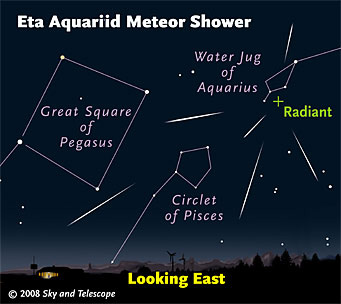
Sky & Telescope diagram
May 6: The Eta Aquariids
This annual shower originates from none other than Halley's Comet, and these meteors come in fast — 41 miles (66 km) per second! At its best, under ideal conditions, the Eta Aquariids can deliver a meteor per minute. But that's not the case this year: the shower's radiant (in the Water Jar asterism of Aquarius) rises late for northerners, and by then the sky will be flooded with light from a waning gibbous Moon.
July 28: The Delta Aquariids
You might see this long-lasting shower called the Southern Delta Aquariids, because its radiant is below the celestial equator and thus best seen from the Southern Hemisphere. Delta Aquariids tend to be faint, and this year they'll be ruined by light from a nearly full Moon. So don't count on seeing more than a few of these meteors per hour.
August 13: The Perseids
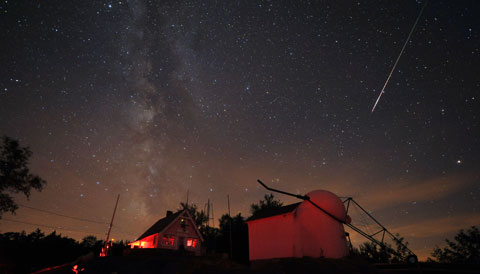
Dennis di Cicco
Even casual skywatchers know about the Perseid meteor shower, because it offers up to 60 an hour under pleasant summer skies. According to the International Meteor Organization, the shower's 2015 peak should come between 6:30 and 9:00 UT, which is ideal for North America, and the just-past-new Moon will not be a factor. So start watching on the evening of the 12th as soon as the radiant (near the Double Cluster in Perseus) clears the horizon, and stay up as late as you can. Dynamicist Jérémie Vauballion (IMCCE, Paris) predicts that an additional pulse of activity might come about 12 hours earlier (best for Asia), when a dust trail shed in 1862 by the Perseids' parent comet, 109P/Swift-Tuttle, is expected to pass very close to near Earth. The story of how 19th-century observers realized this shower is an annual event is interesting reading.
October 22: The Orionids
Here's another modest shower due to Halley's Comet. Light from a waxing gibbous Moon will be a nuisance until it sets around 1 a.m. After that, you might glimpse up to 20 meteors per hour from a dark site in the hours before dawn. The shower’s radiant is located above Orion’s bright reddish star Betelgeuse. That's close enough to the celestial equator for observers in both the Northern and Southern hemispheres to enjoy the show.
November 5: The Southern Taurids
Lasting from mid-September to mid-November, this broad, weak display typically produces at most a dozen meteors per hour at its peak. But in 2005 skywatchers were treated to a "Taurid fireball swarm" dominated by bright, slow-moving fireballs from larger-than-average particles — and that kind of display might happen again this year. According to dynamicist David Asher (Armagh Observatory), we should expect bright Taurid meteors and fireballs from about October 29th to November 10th. During this period the Moon's phase wanes from just-past-full gibbous to just shy of new. The shower’s radiant is in western Taurus, along its border with Cetus.
November 18: The Leonids
The Leonid shower's parent comet, 55P/Tempel-Tuttle, tends to create narrow concentrated streams of debris that produced prodigious displays in the late 1990s, when it last swung close to the Sun. Since then the shower's activity has varied from year to year, usually offering little more than a trickle of shooting stars radiating from Leo’s Sickle. The nominal peak should be around 5:00 UT — great timing for North Americans.
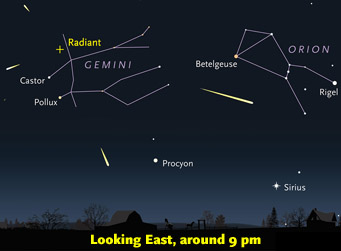
Sky & Telescope diagram
December 14: The Geminids
This end-of-the-calendar shower is usually the year’s best, with upward of 100 meteors per hour radiating from a spot near the bright star Castor. For 2015, the thin, waxing crescent Moon won't be a distraction at all. Even better, the Geminid radiant is well up in the sky by 9 p.m. as seen from at mid-northern latitudes. The only downside is that this shower is relatively brief, and its predicted peak falls in mid-afternoon for North Americans. Geminid meteors come from 3200 Phaethon, an asteroid discovered in 1983 that circles the Sun every 3.3 years.
Keep tabs on meteor showers and all the year's other celestial happenings with SkyWatch 2015, available in digital and print editions.
 0
0